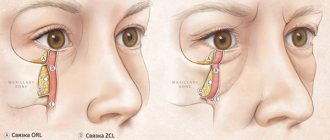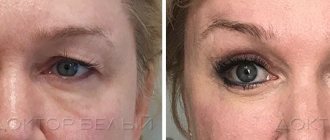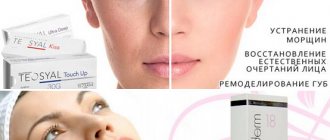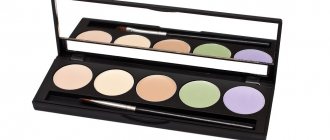The tissue structure of the eyelid contains virtually no subcutaneous tissue; in combination with a certain genetic predisposition and idiopathic factors, i.e. increased risks due to the constitutional characteristics of this particular organism - the continuous and endless blink reflex in some people leads to pathological stretching of the skin of the eyelid. The excess space, gradually increasing, is equally gradually filled with lipid (fat) tissue; a kind of protruding swelling, protrusion, or “bulging” is formed, which in ophthalmology is called a fatty hernia of the eyelid. A hernia can form in both the lower and upper eyelids, in one eye or both.
Causes
As a rule, a more or less complex combination of factors leads to the formation of an eyelid hernia, among which both endogenous (internal) prerequisites and exogenous (external) influences or conditions are found. The most common reasons are:
- genetic predisposition;
- disturbances in the circulation of lymph, blood and intraocular fluid;
- atrophic thinning of the skin of the eyelids;
- unhealthy lifestyle (primarily situations of chronic stress and lack of sleep);
- hormonal fluctuations and changes;
- chronic overload of the visual system;
- special structure of the orbital bones.
Read also
All articles Quality and skin problems
Forehead
- Forehead wrinkles
- Eyebrow wrinkles and folds
- Replenishment of the volume of the temporal region
Face
- Wrinkles around the eyes
- Hernias of the eyelids
- Drooping eyelid skin
- Dry eyelid skin
- Correction of the nasolacrimal trough
- Dark circles under the eyes
- Swelling of the eyelids
- Correction of the nasal bridge
- Enlargement and reshaping of cheekbones
- Age-related volume deficit on the face
- Nasolabial folds
- Rabbit wrinkles
Lips
- Lip augmentation and reshaping
- Correction of drooping corners of the lips
- Elimination of dry lips
- Purse-string wrinkles around the lips
- Marionette wrinkles
How to determine the presence of hernias
For self-diagnosis of a lower eyelid hernia, as a rule, an ordinary mirror is sufficient. Identifying a hernia of the upper eyelid, even if it is practically invisible, is also not difficult: with your eye closed, it is enough to carefully palpate the eyelid in the area adjacent to the bridge of the nose; a fatty hernia is felt by the fingers as a swollen area of skin compared to the surrounding tissues. Regardless of the location and severity of the hernia, it is best to consult with an ophthalmologist (at least to make sure that it is a hernia and not some other, much more dangerous formation).
Hernias under the eyes: what is it and why do they appear?
Hernias under the eyes occur due to the anatomical features of the orbit or are the result of natural aging of the body. The skin under the eyes is very thin and over the years it loses its elasticity. If fatty tissue, which protects the eyes from various damage, gets underneath it, bags under the eyes appear. They do not hurt, do not cause itching or other discomfort, but they negatively affect a person’s appearance.
Most often, hernias occur under the eyes in women over 30 years of age. It is almost impossible to hide them with cosmetics. A woman with bags under her eyes always looks tired, sleep-deprived, and gloomy. In addition, hernias visually increase a person’s age. If the fatty bags under the eyes become larger and no measures are taken to remove them, they begin to put pressure on the nasolacrimal ducts. This leads to watery eyes and even blurred vision.
Bags under the eyes appear as a result of overwork, insomnia or alcohol abuse. They usually go away, you just need to rest a little, get some sleep, or apply a compress with ice, tea and other folk remedies to your eyes.
It is quite simple to distinguish fatty hernias from bags. You need to lightly press your finger on the eyeball. If the swelling under the eye has increased, then this is indeed a hernia.
Why do fatty hernias appear under the eyes?
Although hernias occur as a result of aging, not everyone gets them. The following reasons can provoke their occurrence:
- metabolic disease;
- skin diseases;
- stress, insomnia, overwork;
- alcoholism, smoking, unhealthy diet;
- exposure to ultraviolet radiation;
- constant use of cosmetics;
- paresis, paralysis of the eyelids;
- circulatory disorders.
Often the cause of hernias under the eyes is a genetic factor. Fatty formations can occur under the lower eyelids and under the upper eyelids. In the second case, they begin to hang over the eyes, which over time leads to a decrease in visual functions.
Do eyelid hernias need to be removed?
If a specialist has reliably confirmed that the bulge is a hernia and nothing more, there is no need to worry about your general health or vision, since the hernia does not pose any actual threat. At the same time, any structural and anatomical deformations in the eye area are very noticeable and form a significant cosmetic defect, unacceptable for many (most) patients.
Regardless of whether a hernia of the eyelid is caused by age-related changes or is genetically predetermined, it is eliminated through a fairly simple, quick and safe ophthalmic surgical correction. When planning this type of intervention, the following goals are usually set:
- elimination of all existing hernias (on the upper and lower eyelids, in both eyes) with one operation;
- if necessary and according to indications, simultaneous elimination of other defects and anomalies (vascular networks, irregular nasolabial fold, etc.);
- painless, seamless, microinvasive (i.e. surgical access without incisions);
- rejuvenating aesthetic effect.
Depending on the individual situation, in some cases general anesthesia or sedative premedication may be used, but most often local anesthesia is more than sufficient.
Solution for age-related changes
But what to do when these hernias are already an age-related change, this hernia is not one or two, but here such sausages lie under the eyes, in addition to the sausages under the eyes, the skin is also of rather poor quality, it is covered with a network of wrinkles, all these hernias swell endlessly , eyes become unattractive? I want to say that this problem, when it is already an age-related problem, and not early development, it is difficult to solve. That is, this is not a cosmetic problem at all, this is, unfortunately, a problem for plastic surgeons. They, and only they, can solve this complex problem, when there are already several hernias, when there is swelling, when the skin flap is already large enough, this skin turgor cannot be improved anywhere. Then, of course, the best solution is plastic surgery.
Types of operations
Various operating techniques exist and are practiced, but today two approaches can be considered standard:
- excision of excess dermal and lipid tissue with a scalpel; Despite the somewhat frightening sound of the procedure, in fact the operation is low-traumatic and does not lead to significant scarring or the need for long-term rehabilitation: natural regenerative processes heal the surgical field quickly and do not leave noticeable scars;
- surgical access in the form of a puncture through the conjunctiva; This technique leaves no traces at all and is practically not felt by the patient.
Thus, a short, minimally invasive plastic surgery can eliminate a cosmetic defect for many years. The risk of postoperative complications or side effects tends to zero, however, to eliminate them, the following mandatory instructions must be observed:
- do not try to get rid of the postoperative patch on your own initiative (for example, with the motivation “everything has healed for a long time and I really want to see it quickly”);
- apply (as often and for a long time as the doctor prescribes) cold compresses to prevent possible pain or discomfort in the postoperative period, as well as to relieve swelling and puffiness;
- limit any physical activity, avoid body positions in which the head is tilted forward;
- follow all other individual recommendations if they are given by the doctor (for example, re-examination after a certain time or taking anti-inflammatory or bactericidal drugs).
You can't spoil porridge with oil
But there are such patients, such women and men, who are categorically against surgical intervention. And we, cosmetologists, also need to accept and understand this: no matter how much we persuade our patients to resort to plastic surgery, there are those who categorically never want to undergo surgery and will not undergo surgery for anything in the world. We must put up with this, we must understand it and then we must act according to the principle “Do no harm.” This is very important here, because this is a big problem that is being solved step by step, step by step. Gradually, gradually, gradually we do one procedure, see how it happened, what has changed, has it become worse? If it gets better, we can repeat the procedure; if there is no effect, we can change the procedure. But in no case does the saying: “You can’t spoil porridge with butter” apply here. It's just a gradual introduction of new procedures step by step: see what happens and take the next step.
Prevention of occurrence
At the earliest stages of hernia formation, you can significantly slow down the process by performing certain preventive eyelid care programs. Such activities usually include massages that stimulate lymph flow and general microcirculation, as well as lifting agents (contour tightening) and gentle peelings.
One should, however, be aware that we are only talking about reducing the rate of hernia formation; Neither massage, nor lifting, nor peeling, nor autohypnosis called “alternative medicine” can stop or, moreover, reverse age-related organic degeneration of tissues. These methods, as a rule, are by no means cheap (with the exception of self-massage, which is in any case useful and has a complex stimulating effect), are effective only up to a certain limit, beyond which, if the patient has not lost interest in his own appearance by that time , the question of surgical eyelid surgery inevitably arises. At this stage, a thoughtful and rationally reasoned choice of clinic becomes of paramount importance.
It is reasonable and advisable to collect reliable information, including reviews of previously operated patients (it is undesirable to take into account rave reviews of “virtual souls” from the Internet), the composition of specialists (qualification category, clinical experience, availability of scientific works and academic titles), as well as staffing and level of equipment, which the ophthalmic center in question has. In addition, despite the seemingly direct path to a specialist in aesthetic surgery, it is safer to entrust your eyes to a highly specialized clinician, i.e. to the ophthalmologist: there are too many nuances and features in this sector of the body, the organization of the visual system is too delicate and fragile.
Let's sum it up
Of course, this could be surgery, but it could also just be botulinum toxin in the forehead area, and this immediately visually tightens the upper eyelid. Of course, this is a very good method, but we cannot use this method of botulinum therapy if we have hernias and swelling under the eyes, because by putting botulinum toxin in this area in an attempt to remove these wrinkles, we get the absolutely opposite effect. We only increase swelling in this area and make the face very, very unattractive.
Therefore, it is a complex problem, together with a cosmetologist you must decide how to move towards solving this problem and gradually, step by step, solve this problem.
How is blepharoplasty performed?
Lower eyelid surgery can be performed using one of two methods: transconjunctival and percutaneous. With the transconjunctival approach, an incision is made on the inside of the eyelid. Next, manipulations are carried out with the periorbital fat - it is redistributed as needed, and excess is removed. This technique does not involve removing excess sagging skin, so it is more suitable for young patients.
Percutaneous lower eyelid surgery is performed through an incision located a few millimeters below the growth of the eyelashes. When the musculocutaneous flap is detached, access to the hernia opens. The doctor can manipulate them under visual control. At the same time, the septum is strengthened and the periorbital muscle is tightened. If necessary, excess skin is excised. Cosmetic stitches are placed on the incision.
1 month after transconjunctival eyelid surgery with Youssef Bassanovich Dergam
4 days after lower eyelid surgery
4 months after transconjunctival eyelid surgery with Dr. Youssef Bassanovich
10 days after transconjunctival lower eyelid surgery with Youssef Bassanovich
5 days after transconjunctival lower eyelid surgery with Youssef Bassanovich
Degrees of progression
Manifestations of lower eyelid ptosis depend on the degree of progression:
- First. It appears in the form of bags under the lower eyelashes - drooping of the skin.
- Second. The tone of the orbicularis muscle decreases and slight sagging occurs.
- Third. Ptosis of the eyelids is accompanied by drooping cheekbones, cheeks and the appearance of nasolabial folds.
- Fourth. Pronounced changes are noted in the area that borders the eyelid. Zygomatic pouches occur, the sclera is exposed, and nasolacrimal grooves appear.
When primary signs of an eyelid hernia appear, it is not recommended to ignore the problem. The pathological process is not only an aesthetic defect. As it progresses, there is an accumulation of fatty deposits, which leads to constant watery eyes. The field of vision narrows and visual impairment occurs.
Can there be complications after lower eyelid surgery?
In a plastic surgery clinic with an experienced team of specialists, the risk of complications is minimized.
There is no need to worry about vision problems, since the surgeon does not touch the eyeball in any way.
However, aesthetic complications are still possible after this operation. For example, in the case of excessive tissue excision, the eyes change shape, become round, and the skin around them is unnaturally stretched, as if theatrical makeup was applied in layers to the face.
This complication is difficult to correct, but in some cases it is possible. Thus, in the practice of the leading surgeon of the clinic, Zaur Bytdaev, a significant percentage of blepharoplasty operations are just a correction after an unsuccessful excision done somewhere in another operating room.
Here's something else interesting
Ideal nose - how to get rid of a hump?
Surgical treatment of bulging eyes - Olivari operation
How to remove a double chin and tighten your neck?
How to get rid of jowls? Lifting, SMAS-lifting, MACS-lift.
Establishing diagnosis
You can determine the onset of pathological disorders yourself. Suspicions should arise when primary signs of fatigue and drooping of the outer corners of the eyes appear. Nature provides for the presence of a small fat reserve in the eyelid area, which is designed to protect the eye from damage. With a pathological disorder, an increase in these deposits is noted. In order to ensure the development of ptosis, you should squeeze the skin in the problem area with two fingers. If compaction occurs, then there is a problem. Ptosis may be asymmetrical. In the lower eyelid, the manifestations of a hernia are usually clear and beyond doubt.
Diagnosis of eyelid ptosis is carried out using the following methods:
- Ultrasound of the eyeball. The most informative and safe study, with the help of which it is possible to assess the condition of surrounding tissues, muscle structures and blood vessels.
- Biological microscopy. Using a slit lamp, the soft tissues of the eyelids are examined in a non-contact manner.
If there are concomitant diseases, additional diagnostics are prescribed. The patient is required to be referred for consultation to a nephrologist and cardiologist, which is necessary due to the development of an eyelid hernia against the background of disorders of the urinary and cardiovascular systems.
Fillers
Knowing the anatomy of the midface and the mechanism of aging, you can now guess how fillers work.
Fillers fill the volume of the middle zone, stretch the soft tissues, temporarily hiding the nasolacrimal groove. But this trick only works with elastic skin and a “strong” orbicularis oculi muscle, i.e. up to a certain age.
I have nothing against fillers, only for them. The main thing is that patients do not think that fillers are an alternative to blepharoplasty. Each method has its own indications and contraindications; do not confuse warm with soft.









